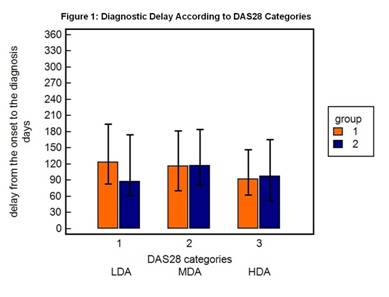Session Information
Session Type: ACR Poster Session A
Session Time: 9:00AM-11:00AM
Background/Purpose: In
the last 10 years a big effort has been made to reduce the diagnostic delay in
patients with early arthritis, in order to start treatment as early as possible
and to improve outcomes. The aim of this study is to
assess whether diagnostic delay in patients evaluated at our Early Arthritis Clinic (EAC)
changed between 2005 and 2014.
Methods: among patients referred to our EAC
(disease duration <12 months) between 01/01/2005 to 31/12/2014, those with a
diagnosis of rheumatoid arthritis (RA) (according to 1987 and/or 2010
classification criteria) or undifferentiated arthritis (UA) with a complete data-set were recruited. Patients were divided
into 2 groups according to the time of diagnosis (group 1: 2005-2009; group 2:
2010-2014). A comparison among demographic and clinical features was performed.
Results: a
total of 513 patients were evaluated: 305 patients into the group 1 (74.8%
women, mean age 58 ys) vs. 208 patients into the
group 2 (73.1% women, mean age 56.5 ys). The time
from the onset of symptoms to the diagnosis showed no differences between
groups (105 days IQR 66-171 vs. 107 IQR 67-177; p= ns). A total of 42% of the
group 1 and 39% of the group 2 had the diagnosis established within 90 days (p= ns); 35.5% vs. 37%
between 3 and 6 months (p= ns); 15% vs. 17% between 6 and 9 (p= ns); 7.5 % vs.
7% between 9 and 12 (p= ns). The delay
from the referral at our EAC to the visit showed no
differences between the groups (20 days IQR 11-31 vs. 20 IQR 13-28; p= ns). At baseline
patients in the group 2 showed lower disease activity as for DAS28 (4.97 ± 1.19
vs. 4.57 ± 1.21; p= 0.0003), number of tender joints (7 IQR 3-13 vs. 5 IQR 2-9;
p= 0.0009), swollen joints (7 IQR 4-12 vs. 5 IQR 3-8; p <0.0001), ESR (24 IQR
13-42 vs. 21 IQR 10-38; p= 0.0051), VAS-GH (44 IQR 25-50 vs. 50 IQR 30-60; p= 0.0056).
In terms of serologic positivity and diagnosis there were no differences (64.6%
of RA patients into the group 1 vs. 67.3% of RA patients into the group 2; p=
ns).
Comparing DAS28 categories at baseline there were no
differences in the diagnostic delay: patients with baseline DAS28 <3.2 had a
delay of 124 days (IQR 88-194) in the group 1 vs. 88 (IQR 62-175) in the group
2 (p= ns); patients with baseline DAS28 between 3.2 and 5.1 had a delay of 116
days (IQR 71-182) vs. 117 (IQR 80-184) (p= ns), patients with baseline DAS28
>5.1 had a delay of 92 days (IQR 63-147) vs. 98 (IQR 52-166) (p= ns) (figure
1).
Conclusion:
the reduction of disease activity observed during 10 years doesn’t depend on a
reduced diagnostic delay. Currently, up to the 60% of the diagnosis is still
not made within the first 90 days
from the onset of symptoms, period conventionally considered a window of
opportunity. There is therefore a substantial
room for improvement only partially linked to the delay between
the referral at EAC and the diagnosis: education programs for patients and
primary care physicians in order to reduce the diagnostic delay are still necessary.
To cite this abstract in AMA style:
Benaglio F, Balduzzi S, Bugatti S, Sakellariou G, Montecucco C, Caporali R. Diagnostic Delay in Early Arthritis: Ten Years-Experience of a Single Center [abstract]. Arthritis Rheumatol. 2015; 67 (suppl 10). https://acrabstracts.org/abstract/diagnostic-delay-in-early-arthritis-ten-years-experience-of-a-single-center/. Accessed .« Back to 2015 ACR/ARHP Annual Meeting
ACR Meeting Abstracts - https://acrabstracts.org/abstract/diagnostic-delay-in-early-arthritis-ten-years-experience-of-a-single-center/

